Engineering System Design: Sydney Harbour Bridge Design Process
VerifiedAdded on 2023/06/08
|12
|3107
|470
Report
AI Summary
This report provides a comprehensive analysis of the design process of the Sydney Harbour Bridge, examining its conceptual design phase within a systems engineering framework. The paper delves into the needs definition that drove the bridge's construction, highlighting the necessity of connecting the north and south shores of Sydney Harbour. It explores two proposed designs: the truss bridge and the arch bridge, evaluating their feasibility and engineering considerations. The report details the feasibility study, system planning, functional analysis, and system operation requirements, including traffic management and toll systems. Furthermore, it outlines the construction process, emphasizing the roles of key figures like Dr. John Bradfield and Sir Ralph Freeman. The evaluation section assesses the bridge's performance, and the conclusion summarizes the key findings, underscoring the Sydney Harbour Bridge's significance as an engineering achievement. The report also includes an overview of the bridge's maintenance and support systems.
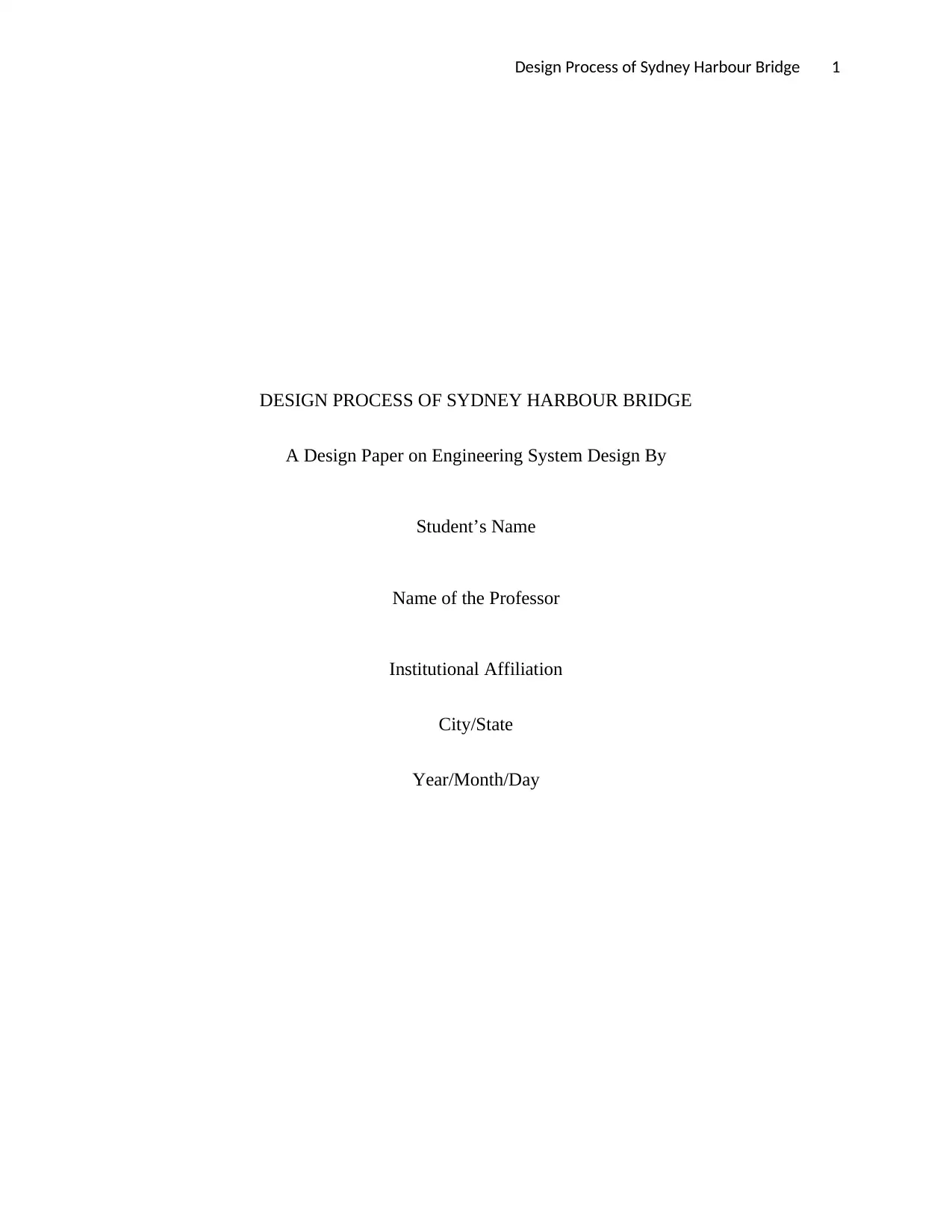
Design Process of Sydney Harbour Bridge 1
DESIGN PROCESS OF SYDNEY HARBOUR BRIDGE
A Design Paper on Engineering System Design By
Student’s Name
Name of the Professor
Institutional Affiliation
City/State
Year/Month/Day
DESIGN PROCESS OF SYDNEY HARBOUR BRIDGE
A Design Paper on Engineering System Design By
Student’s Name
Name of the Professor
Institutional Affiliation
City/State
Year/Month/Day
Paraphrase This Document
Need a fresh take? Get an instant paraphrase of this document with our AI Paraphraser
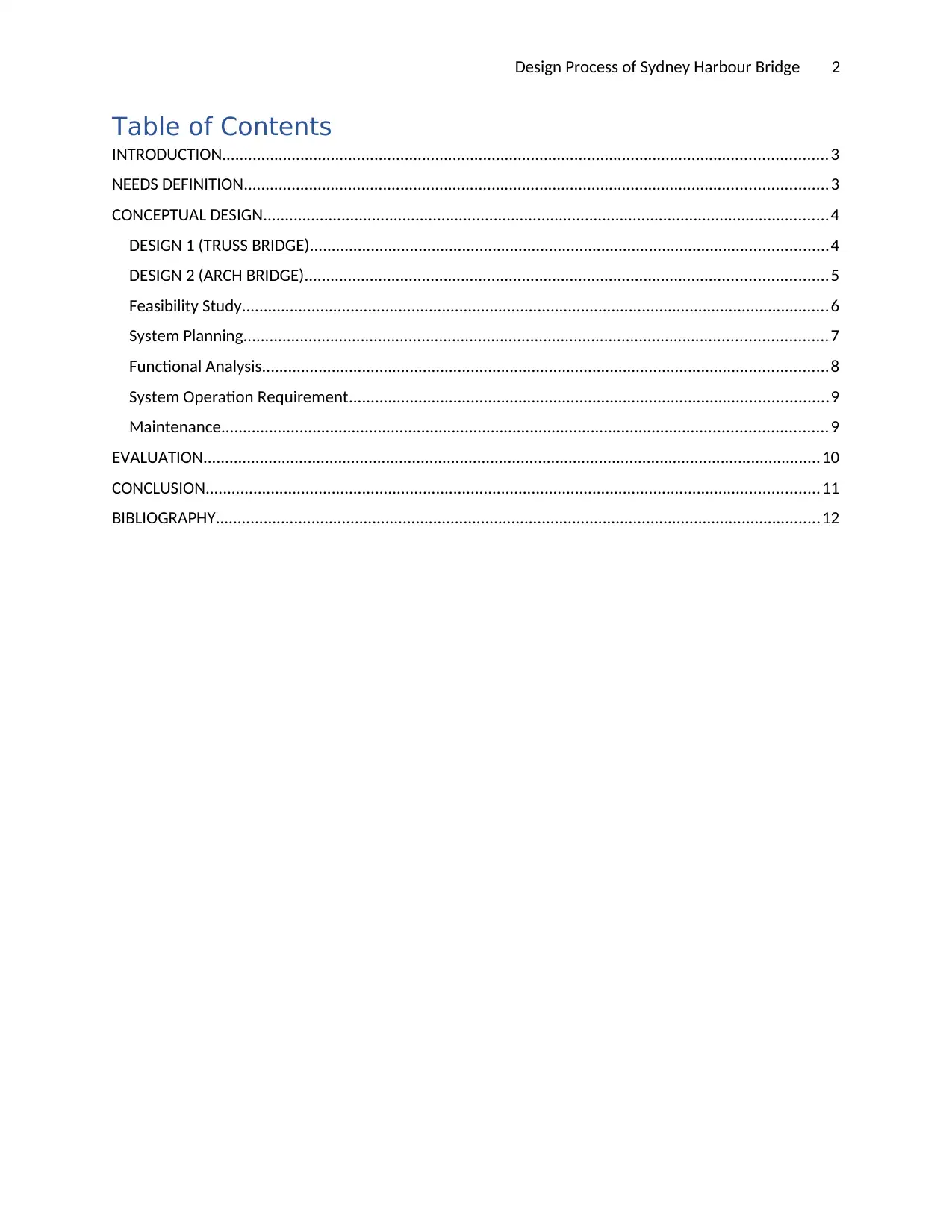
Design Process of Sydney Harbour Bridge 2
Table of Contents
INTRODUCTION...........................................................................................................................................3
NEEDS DEFINITION......................................................................................................................................3
CONCEPTUAL DESIGN..................................................................................................................................4
DESIGN 1 (TRUSS BRIDGE).......................................................................................................................4
DESIGN 2 (ARCH BRIDGE)........................................................................................................................5
Feasibility Study.......................................................................................................................................6
System Planning......................................................................................................................................7
Functional Analysis..................................................................................................................................8
System Operation Requirement..............................................................................................................9
Maintenance...........................................................................................................................................9
EVALUATION..............................................................................................................................................10
CONCLUSION.............................................................................................................................................11
BIBLIOGRAPHY...........................................................................................................................................12
Table of Contents
INTRODUCTION...........................................................................................................................................3
NEEDS DEFINITION......................................................................................................................................3
CONCEPTUAL DESIGN..................................................................................................................................4
DESIGN 1 (TRUSS BRIDGE).......................................................................................................................4
DESIGN 2 (ARCH BRIDGE)........................................................................................................................5
Feasibility Study.......................................................................................................................................6
System Planning......................................................................................................................................7
Functional Analysis..................................................................................................................................8
System Operation Requirement..............................................................................................................9
Maintenance...........................................................................................................................................9
EVALUATION..............................................................................................................................................10
CONCLUSION.............................................................................................................................................11
BIBLIOGRAPHY...........................................................................................................................................12
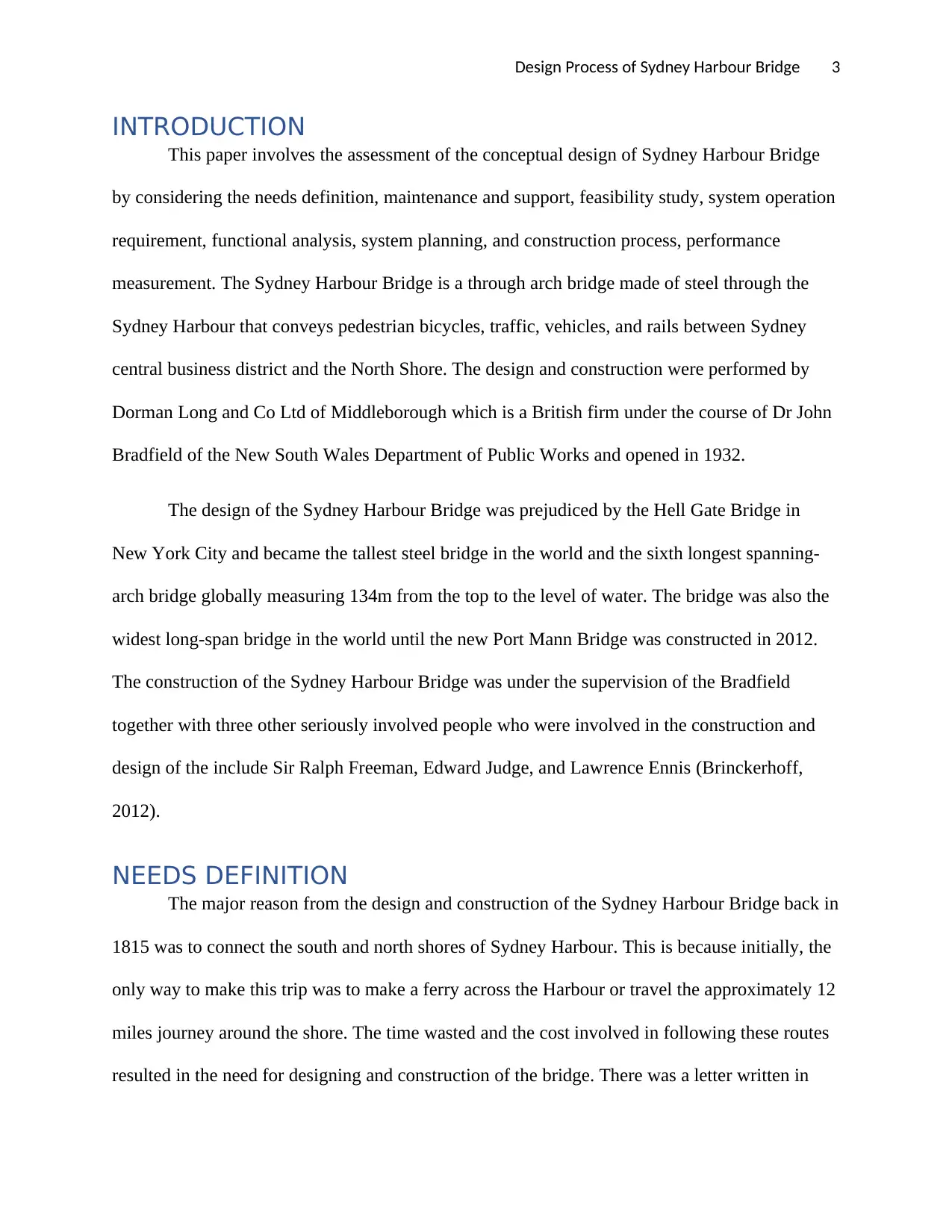
Design Process of Sydney Harbour Bridge 3
INTRODUCTION
This paper involves the assessment of the conceptual design of Sydney Harbour Bridge
by considering the needs definition, maintenance and support, feasibility study, system operation
requirement, functional analysis, system planning, and construction process, performance
measurement. The Sydney Harbour Bridge is a through arch bridge made of steel through the
Sydney Harbour that conveys pedestrian bicycles, traffic, vehicles, and rails between Sydney
central business district and the North Shore. The design and construction were performed by
Dorman Long and Co Ltd of Middleborough which is a British firm under the course of Dr John
Bradfield of the New South Wales Department of Public Works and opened in 1932.
The design of the Sydney Harbour Bridge was prejudiced by the Hell Gate Bridge in
New York City and became the tallest steel bridge in the world and the sixth longest spanning-
arch bridge globally measuring 134m from the top to the level of water. The bridge was also the
widest long-span bridge in the world until the new Port Mann Bridge was constructed in 2012.
The construction of the Sydney Harbour Bridge was under the supervision of the Bradfield
together with three other seriously involved people who were involved in the construction and
design of the include Sir Ralph Freeman, Edward Judge, and Lawrence Ennis (Brinckerhoff,
2012).
NEEDS DEFINITION
The major reason from the design and construction of the Sydney Harbour Bridge back in
1815 was to connect the south and north shores of Sydney Harbour. This is because initially, the
only way to make this trip was to make a ferry across the Harbour or travel the approximately 12
miles journey around the shore. The time wasted and the cost involved in following these routes
resulted in the need for designing and construction of the bridge. There was a letter written in
INTRODUCTION
This paper involves the assessment of the conceptual design of Sydney Harbour Bridge
by considering the needs definition, maintenance and support, feasibility study, system operation
requirement, functional analysis, system planning, and construction process, performance
measurement. The Sydney Harbour Bridge is a through arch bridge made of steel through the
Sydney Harbour that conveys pedestrian bicycles, traffic, vehicles, and rails between Sydney
central business district and the North Shore. The design and construction were performed by
Dorman Long and Co Ltd of Middleborough which is a British firm under the course of Dr John
Bradfield of the New South Wales Department of Public Works and opened in 1932.
The design of the Sydney Harbour Bridge was prejudiced by the Hell Gate Bridge in
New York City and became the tallest steel bridge in the world and the sixth longest spanning-
arch bridge globally measuring 134m from the top to the level of water. The bridge was also the
widest long-span bridge in the world until the new Port Mann Bridge was constructed in 2012.
The construction of the Sydney Harbour Bridge was under the supervision of the Bradfield
together with three other seriously involved people who were involved in the construction and
design of the include Sir Ralph Freeman, Edward Judge, and Lawrence Ennis (Brinckerhoff,
2012).
NEEDS DEFINITION
The major reason from the design and construction of the Sydney Harbour Bridge back in
1815 was to connect the south and north shores of Sydney Harbour. This is because initially, the
only way to make this trip was to make a ferry across the Harbour or travel the approximately 12
miles journey around the shore. The time wasted and the cost involved in following these routes
resulted in the need for designing and construction of the bridge. There was a letter written in
⊘ This is a preview!⊘
Do you want full access?
Subscribe today to unlock all pages.

Trusted by 1+ million students worldwide
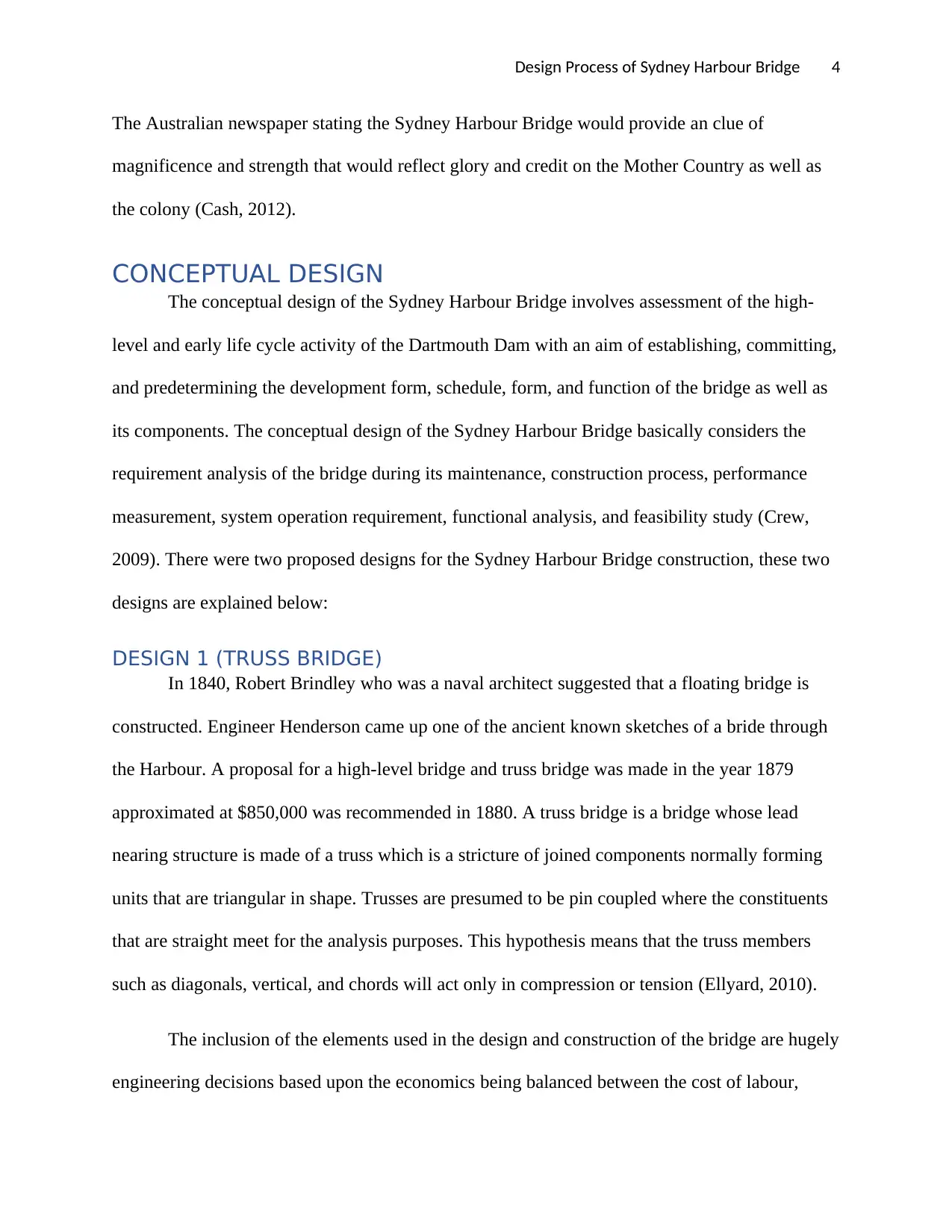
Design Process of Sydney Harbour Bridge 4
The Australian newspaper stating the Sydney Harbour Bridge would provide an clue of
magnificence and strength that would reflect glory and credit on the Mother Country as well as
the colony (Cash, 2012).
CONCEPTUAL DESIGN
The conceptual design of the Sydney Harbour Bridge involves assessment of the high-
level and early life cycle activity of the Dartmouth Dam with an aim of establishing, committing,
and predetermining the development form, schedule, form, and function of the bridge as well as
its components. The conceptual design of the Sydney Harbour Bridge basically considers the
requirement analysis of the bridge during its maintenance, construction process, performance
measurement, system operation requirement, functional analysis, and feasibility study (Crew,
2009). There were two proposed designs for the Sydney Harbour Bridge construction, these two
designs are explained below:
DESIGN 1 (TRUSS BRIDGE)
In 1840, Robert Brindley who was a naval architect suggested that a floating bridge is
constructed. Engineer Henderson came up one of the ancient known sketches of a bride through
the Harbour. A proposal for a high-level bridge and truss bridge was made in the year 1879
approximated at $850,000 was recommended in 1880. A truss bridge is a bridge whose lead
nearing structure is made of a truss which is a stricture of joined components normally forming
units that are triangular in shape. Trusses are presumed to be pin coupled where the constituents
that are straight meet for the analysis purposes. This hypothesis means that the truss members
such as diagonals, vertical, and chords will act only in compression or tension (Ellyard, 2010).
The inclusion of the elements used in the design and construction of the bridge are hugely
engineering decisions based upon the economics being balanced between the cost of labour,
The Australian newspaper stating the Sydney Harbour Bridge would provide an clue of
magnificence and strength that would reflect glory and credit on the Mother Country as well as
the colony (Cash, 2012).
CONCEPTUAL DESIGN
The conceptual design of the Sydney Harbour Bridge involves assessment of the high-
level and early life cycle activity of the Dartmouth Dam with an aim of establishing, committing,
and predetermining the development form, schedule, form, and function of the bridge as well as
its components. The conceptual design of the Sydney Harbour Bridge basically considers the
requirement analysis of the bridge during its maintenance, construction process, performance
measurement, system operation requirement, functional analysis, and feasibility study (Crew,
2009). There were two proposed designs for the Sydney Harbour Bridge construction, these two
designs are explained below:
DESIGN 1 (TRUSS BRIDGE)
In 1840, Robert Brindley who was a naval architect suggested that a floating bridge is
constructed. Engineer Henderson came up one of the ancient known sketches of a bride through
the Harbour. A proposal for a high-level bridge and truss bridge was made in the year 1879
approximated at $850,000 was recommended in 1880. A truss bridge is a bridge whose lead
nearing structure is made of a truss which is a stricture of joined components normally forming
units that are triangular in shape. Trusses are presumed to be pin coupled where the constituents
that are straight meet for the analysis purposes. This hypothesis means that the truss members
such as diagonals, vertical, and chords will act only in compression or tension (Ellyard, 2010).
The inclusion of the elements used in the design and construction of the bridge are hugely
engineering decisions based upon the economics being balanced between the cost of labour,
Paraphrase This Document
Need a fresh take? Get an instant paraphrase of this document with our AI Paraphraser
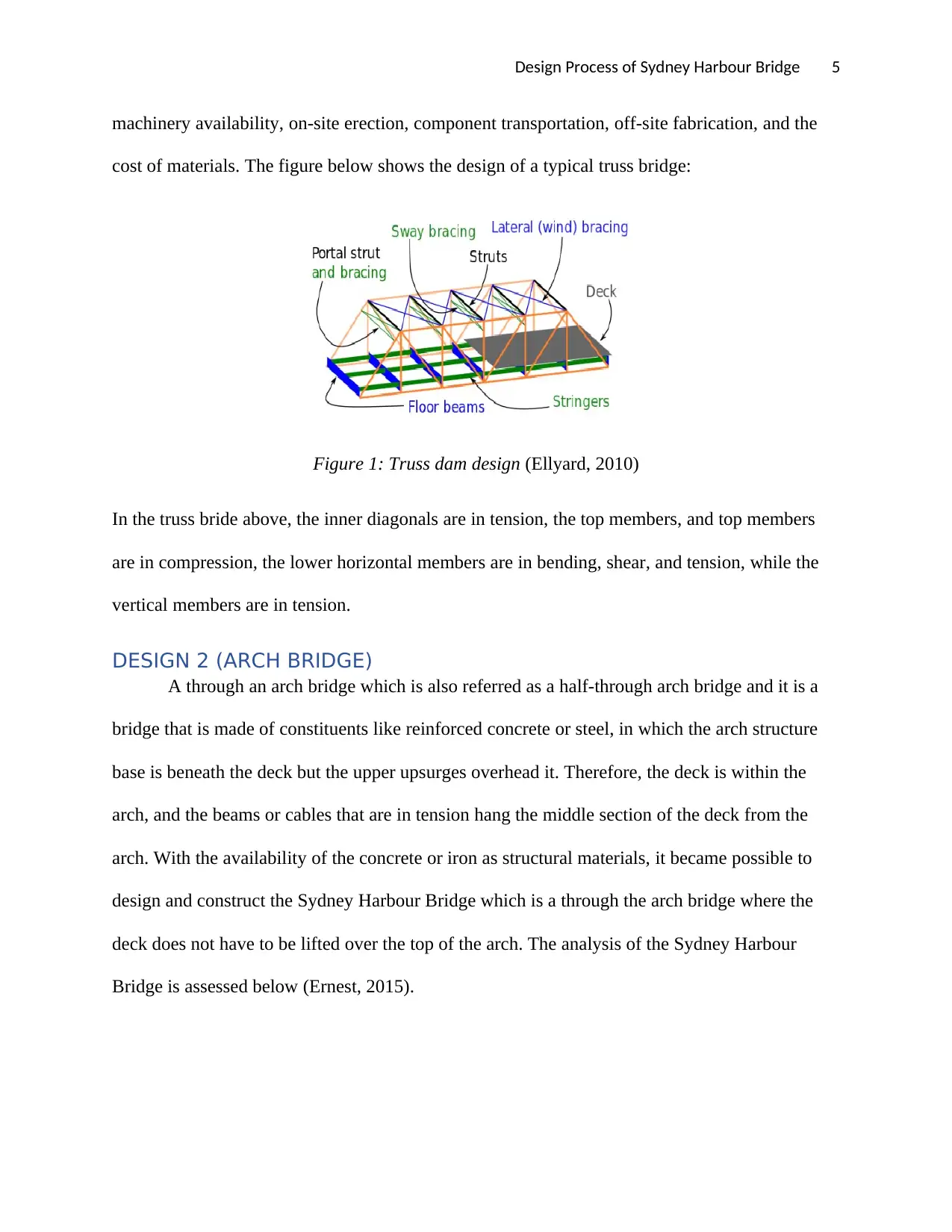
Design Process of Sydney Harbour Bridge 5
machinery availability, on-site erection, component transportation, off-site fabrication, and the
cost of materials. The figure below shows the design of a typical truss bridge:
Figure 1: Truss dam design (Ellyard, 2010)
In the truss bride above, the inner diagonals are in tension, the top members, and top members
are in compression, the lower horizontal members are in bending, shear, and tension, while the
vertical members are in tension.
DESIGN 2 (ARCH BRIDGE)
A through an arch bridge which is also referred as a half-through arch bridge and it is a
bridge that is made of constituents like reinforced concrete or steel, in which the arch structure
base is beneath the deck but the upper upsurges overhead it. Therefore, the deck is within the
arch, and the beams or cables that are in tension hang the middle section of the deck from the
arch. With the availability of the concrete or iron as structural materials, it became possible to
design and construct the Sydney Harbour Bridge which is a through the arch bridge where the
deck does not have to be lifted over the top of the arch. The analysis of the Sydney Harbour
Bridge is assessed below (Ernest, 2015).
machinery availability, on-site erection, component transportation, off-site fabrication, and the
cost of materials. The figure below shows the design of a typical truss bridge:
Figure 1: Truss dam design (Ellyard, 2010)
In the truss bride above, the inner diagonals are in tension, the top members, and top members
are in compression, the lower horizontal members are in bending, shear, and tension, while the
vertical members are in tension.
DESIGN 2 (ARCH BRIDGE)
A through an arch bridge which is also referred as a half-through arch bridge and it is a
bridge that is made of constituents like reinforced concrete or steel, in which the arch structure
base is beneath the deck but the upper upsurges overhead it. Therefore, the deck is within the
arch, and the beams or cables that are in tension hang the middle section of the deck from the
arch. With the availability of the concrete or iron as structural materials, it became possible to
design and construct the Sydney Harbour Bridge which is a through the arch bridge where the
deck does not have to be lifted over the top of the arch. The analysis of the Sydney Harbour
Bridge is assessed below (Ernest, 2015).
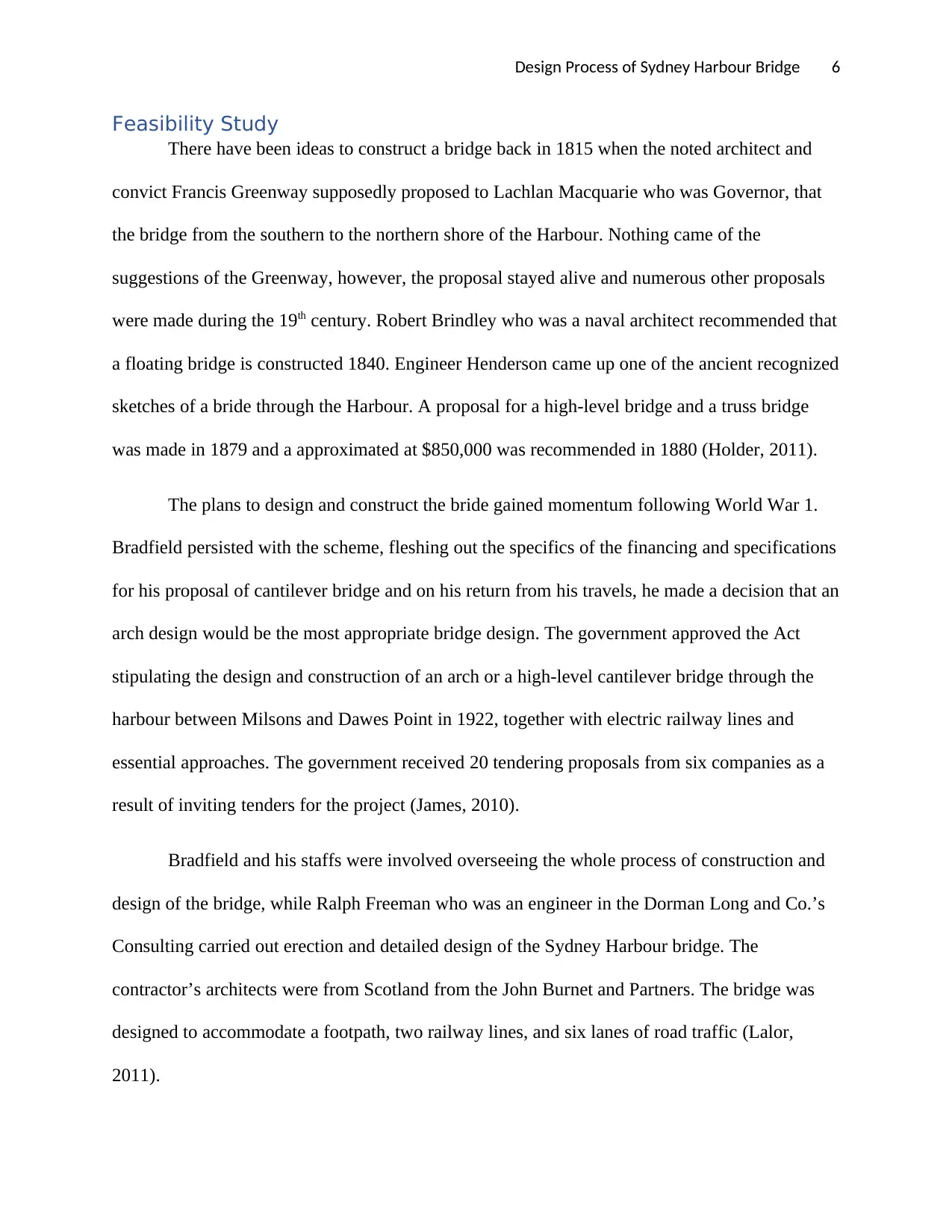
Design Process of Sydney Harbour Bridge 6
Feasibility Study
There have been ideas to construct a bridge back in 1815 when the noted architect and
convict Francis Greenway supposedly proposed to Lachlan Macquarie who was Governor, that
the bridge from the southern to the northern shore of the Harbour. Nothing came of the
suggestions of the Greenway, however, the proposal stayed alive and numerous other proposals
were made during the 19th century. Robert Brindley who was a naval architect recommended that
a floating bridge is constructed 1840. Engineer Henderson came up one of the ancient recognized
sketches of a bride through the Harbour. A proposal for a high-level bridge and a truss bridge
was made in 1879 and a approximated at $850,000 was recommended in 1880 (Holder, 2011).
The plans to design and construct the bride gained momentum following World War 1.
Bradfield persisted with the scheme, fleshing out the specifics of the financing and specifications
for his proposal of cantilever bridge and on his return from his travels, he made a decision that an
arch design would be the most appropriate bridge design. The government approved the Act
stipulating the design and construction of an arch or a high-level cantilever bridge through the
harbour between Milsons and Dawes Point in 1922, together with electric railway lines and
essential approaches. The government received 20 tendering proposals from six companies as a
result of inviting tenders for the project (James, 2010).
Bradfield and his staffs were involved overseeing the whole process of construction and
design of the bridge, while Ralph Freeman who was an engineer in the Dorman Long and Co.’s
Consulting carried out erection and detailed design of the Sydney Harbour bridge. The
contractor’s architects were from Scotland from the John Burnet and Partners. The bridge was
designed to accommodate a footpath, two railway lines, and six lanes of road traffic (Lalor,
2011).
Feasibility Study
There have been ideas to construct a bridge back in 1815 when the noted architect and
convict Francis Greenway supposedly proposed to Lachlan Macquarie who was Governor, that
the bridge from the southern to the northern shore of the Harbour. Nothing came of the
suggestions of the Greenway, however, the proposal stayed alive and numerous other proposals
were made during the 19th century. Robert Brindley who was a naval architect recommended that
a floating bridge is constructed 1840. Engineer Henderson came up one of the ancient recognized
sketches of a bride through the Harbour. A proposal for a high-level bridge and a truss bridge
was made in 1879 and a approximated at $850,000 was recommended in 1880 (Holder, 2011).
The plans to design and construct the bride gained momentum following World War 1.
Bradfield persisted with the scheme, fleshing out the specifics of the financing and specifications
for his proposal of cantilever bridge and on his return from his travels, he made a decision that an
arch design would be the most appropriate bridge design. The government approved the Act
stipulating the design and construction of an arch or a high-level cantilever bridge through the
harbour between Milsons and Dawes Point in 1922, together with electric railway lines and
essential approaches. The government received 20 tendering proposals from six companies as a
result of inviting tenders for the project (James, 2010).
Bradfield and his staffs were involved overseeing the whole process of construction and
design of the bridge, while Ralph Freeman who was an engineer in the Dorman Long and Co.’s
Consulting carried out erection and detailed design of the Sydney Harbour bridge. The
contractor’s architects were from Scotland from the John Burnet and Partners. The bridge was
designed to accommodate a footpath, two railway lines, and six lanes of road traffic (Lalor,
2011).
⊘ This is a preview!⊘
Do you want full access?
Subscribe today to unlock all pages.

Trusted by 1+ million students worldwide
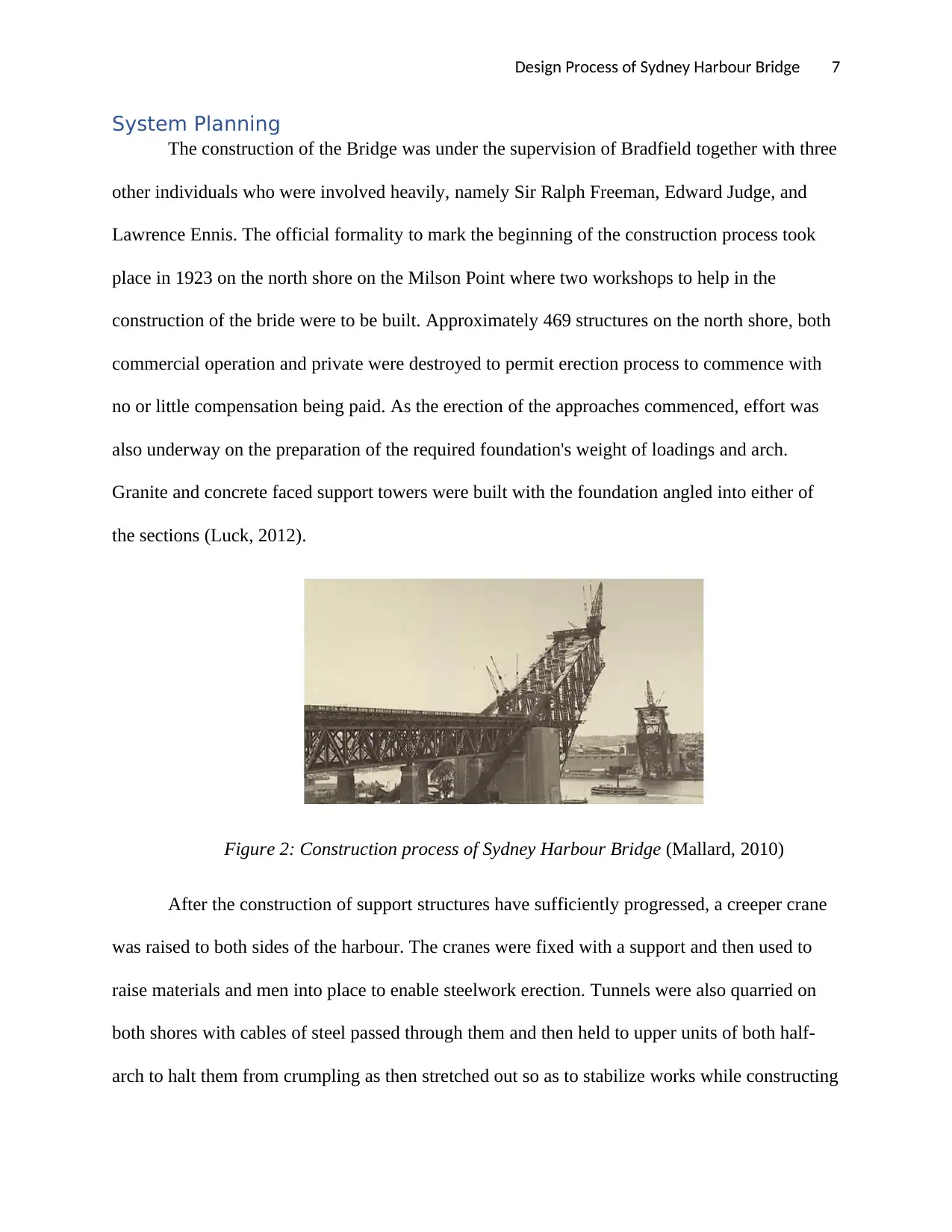
Design Process of Sydney Harbour Bridge 7
System Planning
The construction of the Bridge was under the supervision of Bradfield together with three
other individuals who were involved heavily, namely Sir Ralph Freeman, Edward Judge, and
Lawrence Ennis. The official formality to mark the beginning of the construction process took
place in 1923 on the north shore on the Milson Point where two workshops to help in the
construction of the bride were to be built. Approximately 469 structures on the north shore, both
commercial operation and private were destroyed to permit erection process to commence with
no or little compensation being paid. As the erection of the approaches commenced, effort was
also underway on the preparation of the required foundation's weight of loadings and arch.
Granite and concrete faced support towers were built with the foundation angled into either of
the sections (Luck, 2012).
Figure 2: Construction process of Sydney Harbour Bridge (Mallard, 2010)
After the construction of support structures have sufficiently progressed, a creeper crane
was raised to both sides of the harbour. The cranes were fixed with a support and then used to
raise materials and men into place to enable steelwork erection. Tunnels were also quarried on
both shores with cables of steel passed through them and then held to upper units of both half-
arch to halt them from crumpling as then stretched out so as to stabilize works while constructing
System Planning
The construction of the Bridge was under the supervision of Bradfield together with three
other individuals who were involved heavily, namely Sir Ralph Freeman, Edward Judge, and
Lawrence Ennis. The official formality to mark the beginning of the construction process took
place in 1923 on the north shore on the Milson Point where two workshops to help in the
construction of the bride were to be built. Approximately 469 structures on the north shore, both
commercial operation and private were destroyed to permit erection process to commence with
no or little compensation being paid. As the erection of the approaches commenced, effort was
also underway on the preparation of the required foundation's weight of loadings and arch.
Granite and concrete faced support towers were built with the foundation angled into either of
the sections (Luck, 2012).
Figure 2: Construction process of Sydney Harbour Bridge (Mallard, 2010)
After the construction of support structures have sufficiently progressed, a creeper crane
was raised to both sides of the harbour. The cranes were fixed with a support and then used to
raise materials and men into place to enable steelwork erection. Tunnels were also quarried on
both shores with cables of steel passed through them and then held to upper units of both half-
arch to halt them from crumpling as then stretched out so as to stabilize works while constructing
Paraphrase This Document
Need a fresh take? Get an instant paraphrase of this document with our AI Paraphraser
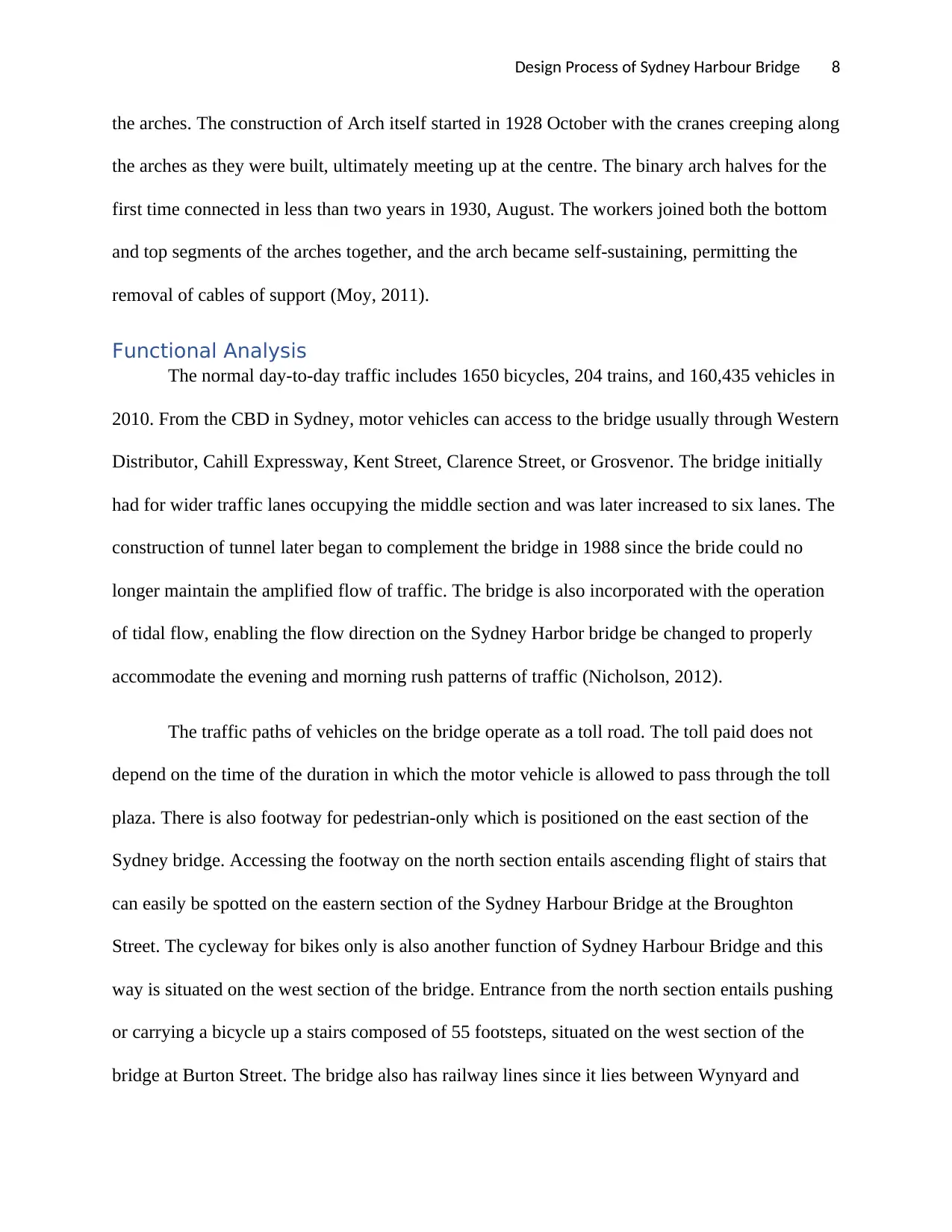
Design Process of Sydney Harbour Bridge 8
the arches. The construction of Arch itself started in 1928 October with the cranes creeping along
the arches as they were built, ultimately meeting up at the centre. The binary arch halves for the
first time connected in less than two years in 1930, August. The workers joined both the bottom
and top segments of the arches together, and the arch became self-sustaining, permitting the
removal of cables of support (Moy, 2011).
Functional Analysis
The normal day-to-day traffic includes 1650 bicycles, 204 trains, and 160,435 vehicles in
2010. From the CBD in Sydney, motor vehicles can access to the bridge usually through Western
Distributor, Cahill Expressway, Kent Street, Clarence Street, or Grosvenor. The bridge initially
had for wider traffic lanes occupying the middle section and was later increased to six lanes. The
construction of tunnel later began to complement the bridge in 1988 since the bride could no
longer maintain the amplified flow of traffic. The bridge is also incorporated with the operation
of tidal flow, enabling the flow direction on the Sydney Harbor bridge be changed to properly
accommodate the evening and morning rush patterns of traffic (Nicholson, 2012).
The traffic paths of vehicles on the bridge operate as a toll road. The toll paid does not
depend on the time of the duration in which the motor vehicle is allowed to pass through the toll
plaza. There is also footway for pedestrian-only which is positioned on the east section of the
Sydney bridge. Accessing the footway on the north section entails ascending flight of stairs that
can easily be spotted on the eastern section of the Sydney Harbour Bridge at the Broughton
Street. The cycleway for bikes only is also another function of Sydney Harbour Bridge and this
way is situated on the west section of the bridge. Entrance from the north section entails pushing
or carrying a bicycle up a stairs composed of 55 footsteps, situated on the west section of the
bridge at Burton Street. The bridge also has railway lines since it lies between Wynyard and
the arches. The construction of Arch itself started in 1928 October with the cranes creeping along
the arches as they were built, ultimately meeting up at the centre. The binary arch halves for the
first time connected in less than two years in 1930, August. The workers joined both the bottom
and top segments of the arches together, and the arch became self-sustaining, permitting the
removal of cables of support (Moy, 2011).
Functional Analysis
The normal day-to-day traffic includes 1650 bicycles, 204 trains, and 160,435 vehicles in
2010. From the CBD in Sydney, motor vehicles can access to the bridge usually through Western
Distributor, Cahill Expressway, Kent Street, Clarence Street, or Grosvenor. The bridge initially
had for wider traffic lanes occupying the middle section and was later increased to six lanes. The
construction of tunnel later began to complement the bridge in 1988 since the bride could no
longer maintain the amplified flow of traffic. The bridge is also incorporated with the operation
of tidal flow, enabling the flow direction on the Sydney Harbor bridge be changed to properly
accommodate the evening and morning rush patterns of traffic (Nicholson, 2012).
The traffic paths of vehicles on the bridge operate as a toll road. The toll paid does not
depend on the time of the duration in which the motor vehicle is allowed to pass through the toll
plaza. There is also footway for pedestrian-only which is positioned on the east section of the
Sydney bridge. Accessing the footway on the north section entails ascending flight of stairs that
can easily be spotted on the eastern section of the Sydney Harbour Bridge at the Broughton
Street. The cycleway for bikes only is also another function of Sydney Harbour Bridge and this
way is situated on the west section of the bridge. Entrance from the north section entails pushing
or carrying a bicycle up a stairs composed of 55 footsteps, situated on the west section of the
bridge at Burton Street. The bridge also has railway lines since it lies between Wynyard and
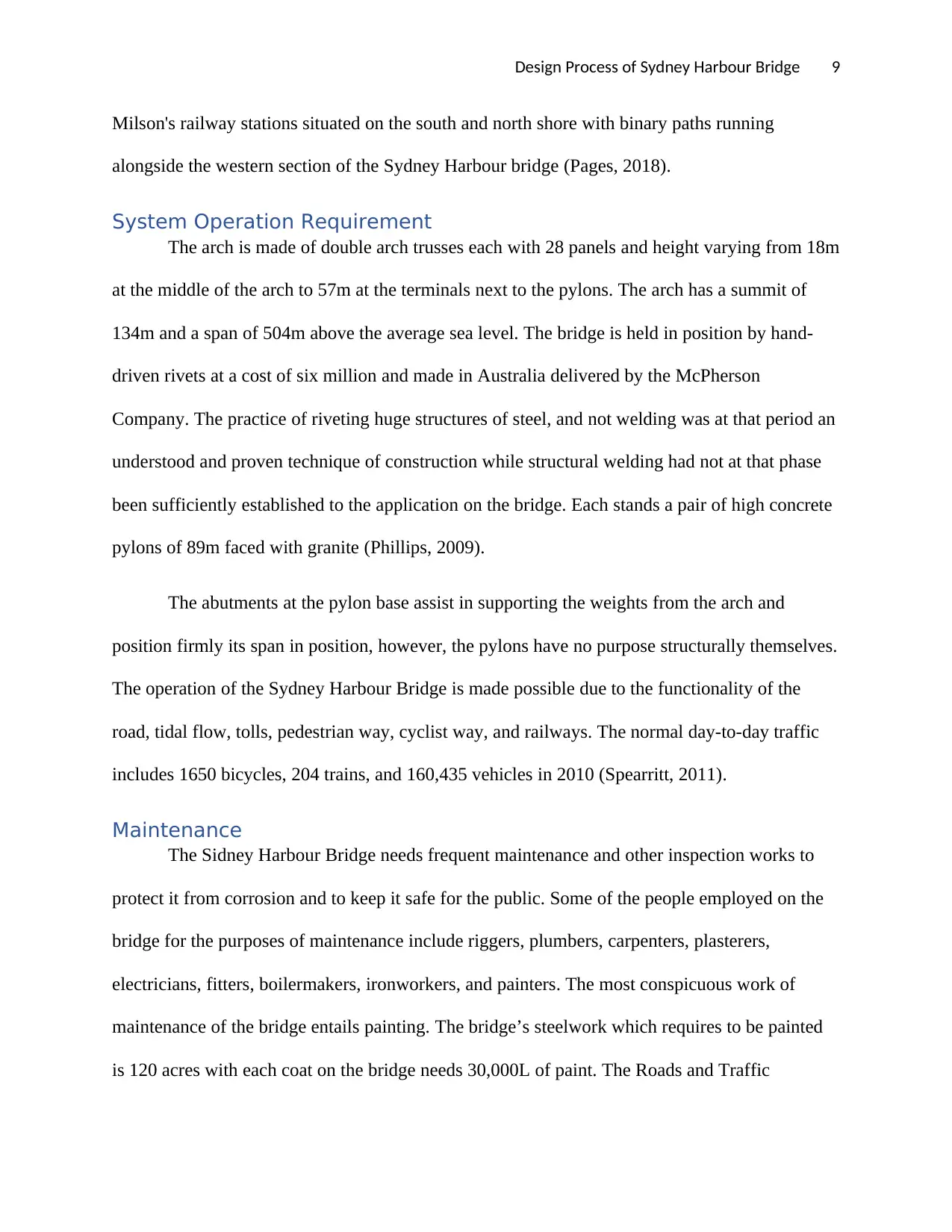
Design Process of Sydney Harbour Bridge 9
Milson's railway stations situated on the south and north shore with binary paths running
alongside the western section of the Sydney Harbour bridge (Pages, 2018).
System Operation Requirement
The arch is made of double arch trusses each with 28 panels and height varying from 18m
at the middle of the arch to 57m at the terminals next to the pylons. The arch has a summit of
134m and a span of 504m above the average sea level. The bridge is held in position by hand-
driven rivets at a cost of six million and made in Australia delivered by the McPherson
Company. The practice of riveting huge structures of steel, and not welding was at that period an
understood and proven technique of construction while structural welding had not at that phase
been sufficiently established to the application on the bridge. Each stands a pair of high concrete
pylons of 89m faced with granite (Phillips, 2009).
The abutments at the pylon base assist in supporting the weights from the arch and
position firmly its span in position, however, the pylons have no purpose structurally themselves.
The operation of the Sydney Harbour Bridge is made possible due to the functionality of the
road, tidal flow, tolls, pedestrian way, cyclist way, and railways. The normal day-to-day traffic
includes 1650 bicycles, 204 trains, and 160,435 vehicles in 2010 (Spearritt, 2011).
Maintenance
The Sidney Harbour Bridge needs frequent maintenance and other inspection works to
protect it from corrosion and to keep it safe for the public. Some of the people employed on the
bridge for the purposes of maintenance include riggers, plumbers, carpenters, plasterers,
electricians, fitters, boilermakers, ironworkers, and painters. The most conspicuous work of
maintenance of the bridge entails painting. The bridge’s steelwork which requires to be painted
is 120 acres with each coat on the bridge needs 30,000L of paint. The Roads and Traffic
Milson's railway stations situated on the south and north shore with binary paths running
alongside the western section of the Sydney Harbour bridge (Pages, 2018).
System Operation Requirement
The arch is made of double arch trusses each with 28 panels and height varying from 18m
at the middle of the arch to 57m at the terminals next to the pylons. The arch has a summit of
134m and a span of 504m above the average sea level. The bridge is held in position by hand-
driven rivets at a cost of six million and made in Australia delivered by the McPherson
Company. The practice of riveting huge structures of steel, and not welding was at that period an
understood and proven technique of construction while structural welding had not at that phase
been sufficiently established to the application on the bridge. Each stands a pair of high concrete
pylons of 89m faced with granite (Phillips, 2009).
The abutments at the pylon base assist in supporting the weights from the arch and
position firmly its span in position, however, the pylons have no purpose structurally themselves.
The operation of the Sydney Harbour Bridge is made possible due to the functionality of the
road, tidal flow, tolls, pedestrian way, cyclist way, and railways. The normal day-to-day traffic
includes 1650 bicycles, 204 trains, and 160,435 vehicles in 2010 (Spearritt, 2011).
Maintenance
The Sidney Harbour Bridge needs frequent maintenance and other inspection works to
protect it from corrosion and to keep it safe for the public. Some of the people employed on the
bridge for the purposes of maintenance include riggers, plumbers, carpenters, plasterers,
electricians, fitters, boilermakers, ironworkers, and painters. The most conspicuous work of
maintenance of the bridge entails painting. The bridge’s steelwork which requires to be painted
is 120 acres with each coat on the bridge needs 30,000L of paint. The Roads and Traffic
⊘ This is a preview!⊘
Do you want full access?
Subscribe today to unlock all pages.

Trusted by 1+ million students worldwide
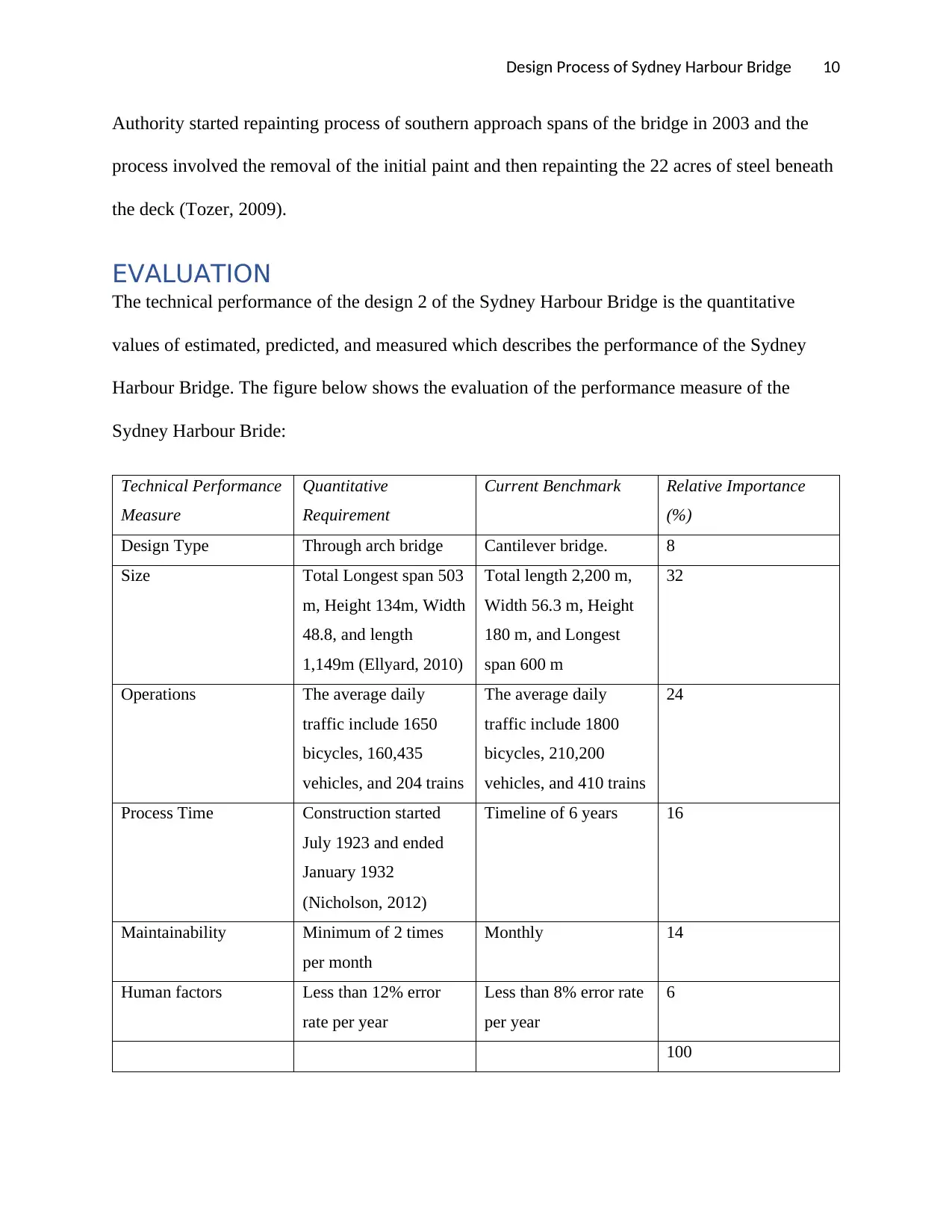
Design Process of Sydney Harbour Bridge 10
Authority started repainting process of southern approach spans of the bridge in 2003 and the
process involved the removal of the initial paint and then repainting the 22 acres of steel beneath
the deck (Tozer, 2009).
EVALUATION
The technical performance of the design 2 of the Sydney Harbour Bridge is the quantitative
values of estimated, predicted, and measured which describes the performance of the Sydney
Harbour Bridge. The figure below shows the evaluation of the performance measure of the
Sydney Harbour Bride:
Technical Performance
Measure
Quantitative
Requirement
Current Benchmark Relative Importance
(%)
Design Type Through arch bridge Cantilever bridge. 8
Size Total Longest span 503
m, Height 134m, Width
48.8, and length
1,149m (Ellyard, 2010)
Total length 2,200 m,
Width 56.3 m, Height
180 m, and Longest
span 600 m
32
Operations The average daily
traffic include 1650
bicycles, 160,435
vehicles, and 204 trains
The average daily
traffic include 1800
bicycles, 210,200
vehicles, and 410 trains
24
Process Time Construction started
July 1923 and ended
January 1932
(Nicholson, 2012)
Timeline of 6 years 16
Maintainability Minimum of 2 times
per month
Monthly 14
Human factors Less than 12% error
rate per year
Less than 8% error rate
per year
6
100
Authority started repainting process of southern approach spans of the bridge in 2003 and the
process involved the removal of the initial paint and then repainting the 22 acres of steel beneath
the deck (Tozer, 2009).
EVALUATION
The technical performance of the design 2 of the Sydney Harbour Bridge is the quantitative
values of estimated, predicted, and measured which describes the performance of the Sydney
Harbour Bridge. The figure below shows the evaluation of the performance measure of the
Sydney Harbour Bride:
Technical Performance
Measure
Quantitative
Requirement
Current Benchmark Relative Importance
(%)
Design Type Through arch bridge Cantilever bridge. 8
Size Total Longest span 503
m, Height 134m, Width
48.8, and length
1,149m (Ellyard, 2010)
Total length 2,200 m,
Width 56.3 m, Height
180 m, and Longest
span 600 m
32
Operations The average daily
traffic include 1650
bicycles, 160,435
vehicles, and 204 trains
The average daily
traffic include 1800
bicycles, 210,200
vehicles, and 410 trains
24
Process Time Construction started
July 1923 and ended
January 1932
(Nicholson, 2012)
Timeline of 6 years 16
Maintainability Minimum of 2 times
per month
Monthly 14
Human factors Less than 12% error
rate per year
Less than 8% error rate
per year
6
100
Paraphrase This Document
Need a fresh take? Get an instant paraphrase of this document with our AI Paraphraser
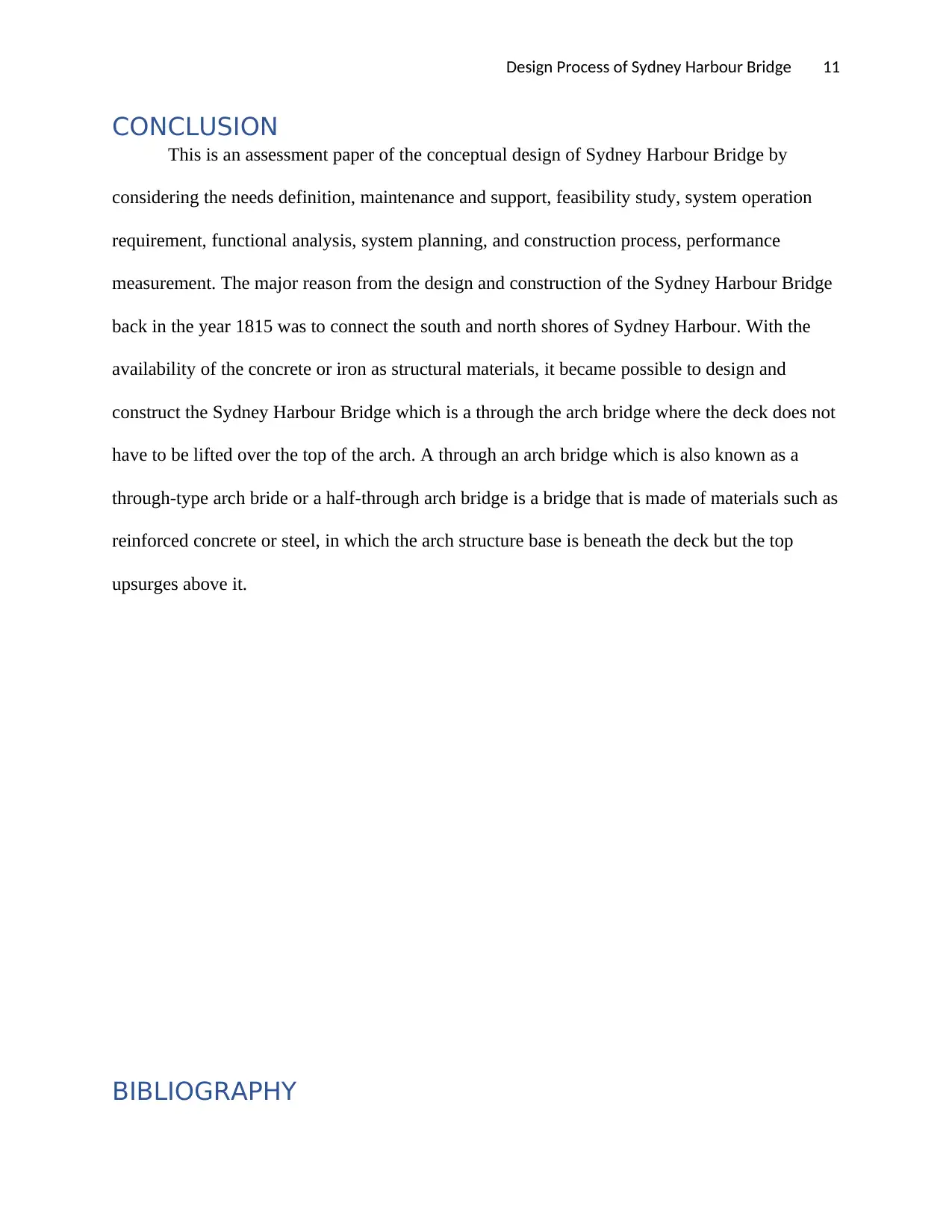
Design Process of Sydney Harbour Bridge 11
CONCLUSION
This is an assessment paper of the conceptual design of Sydney Harbour Bridge by
considering the needs definition, maintenance and support, feasibility study, system operation
requirement, functional analysis, system planning, and construction process, performance
measurement. The major reason from the design and construction of the Sydney Harbour Bridge
back in the year 1815 was to connect the south and north shores of Sydney Harbour. With the
availability of the concrete or iron as structural materials, it became possible to design and
construct the Sydney Harbour Bridge which is a through the arch bridge where the deck does not
have to be lifted over the top of the arch. A through an arch bridge which is also known as a
through-type arch bride or a half-through arch bridge is a bridge that is made of materials such as
reinforced concrete or steel, in which the arch structure base is beneath the deck but the top
upsurges above it.
BIBLIOGRAPHY
CONCLUSION
This is an assessment paper of the conceptual design of Sydney Harbour Bridge by
considering the needs definition, maintenance and support, feasibility study, system operation
requirement, functional analysis, system planning, and construction process, performance
measurement. The major reason from the design and construction of the Sydney Harbour Bridge
back in the year 1815 was to connect the south and north shores of Sydney Harbour. With the
availability of the concrete or iron as structural materials, it became possible to design and
construct the Sydney Harbour Bridge which is a through the arch bridge where the deck does not
have to be lifted over the top of the arch. A through an arch bridge which is also known as a
through-type arch bride or a half-through arch bridge is a bridge that is made of materials such as
reinforced concrete or steel, in which the arch structure base is beneath the deck but the top
upsurges above it.
BIBLIOGRAPHY
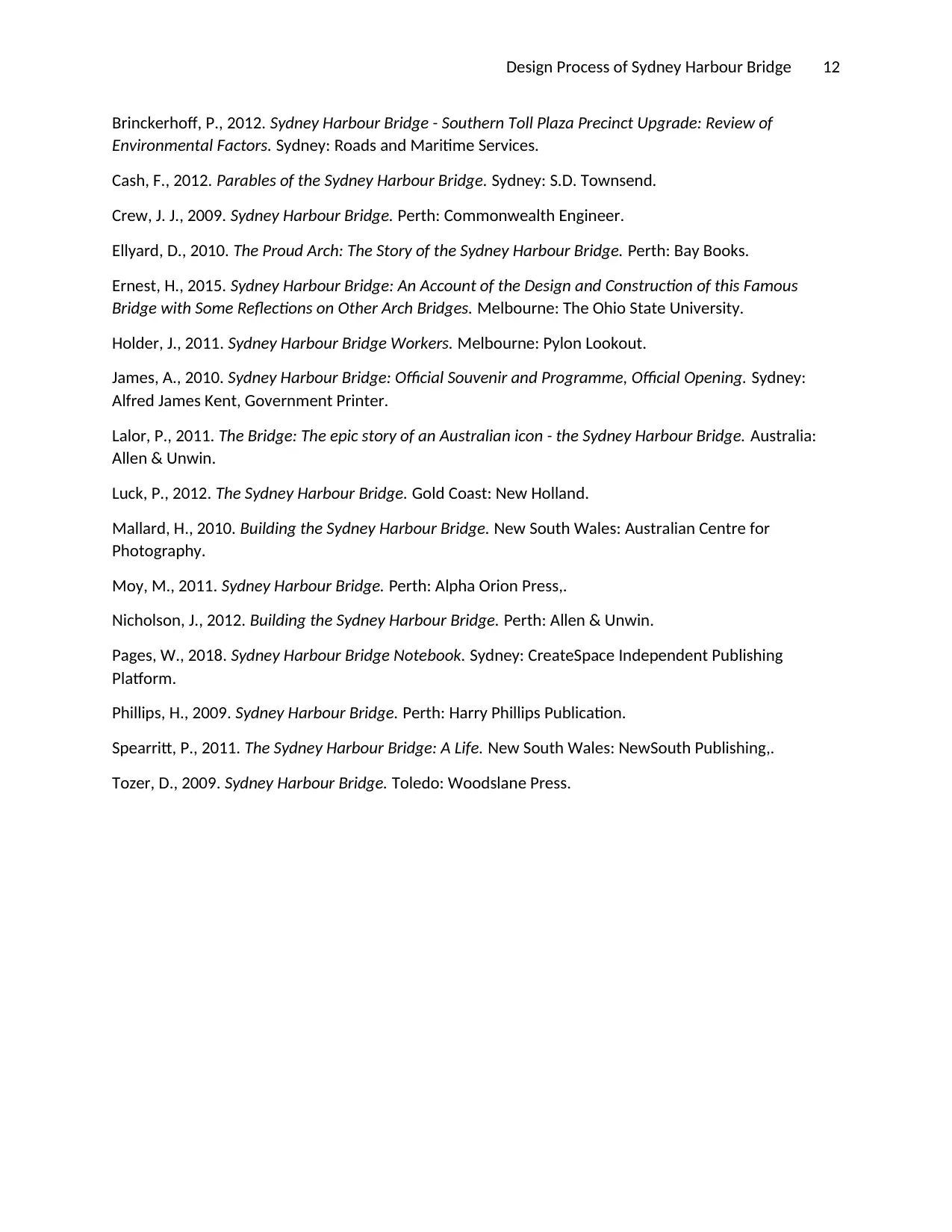
Design Process of Sydney Harbour Bridge 12
Brinckerhoff, P., 2012. Sydney Harbour Bridge - Southern Toll Plaza Precinct Upgrade: Review of
Environmental Factors. Sydney: Roads and Maritime Services.
Cash, F., 2012. Parables of the Sydney Harbour Bridge. Sydney: S.D. Townsend.
Crew, J. J., 2009. Sydney Harbour Bridge. Perth: Commonwealth Engineer.
Ellyard, D., 2010. The Proud Arch: The Story of the Sydney Harbour Bridge. Perth: Bay Books.
Ernest, H., 2015. Sydney Harbour Bridge: An Account of the Design and Construction of this Famous
Bridge with Some Reflections on Other Arch Bridges. Melbourne: The Ohio State University.
Holder, J., 2011. Sydney Harbour Bridge Workers. Melbourne: Pylon Lookout.
James, A., 2010. Sydney Harbour Bridge: Official Souvenir and Programme, Official Opening. Sydney:
Alfred James Kent, Government Printer.
Lalor, P., 2011. The Bridge: The epic story of an Australian icon - the Sydney Harbour Bridge. Australia:
Allen & Unwin.
Luck, P., 2012. The Sydney Harbour Bridge. Gold Coast: New Holland.
Mallard, H., 2010. Building the Sydney Harbour Bridge. New South Wales: Australian Centre for
Photography.
Moy, M., 2011. Sydney Harbour Bridge. Perth: Alpha Orion Press,.
Nicholson, J., 2012. Building the Sydney Harbour Bridge. Perth: Allen & Unwin.
Pages, W., 2018. Sydney Harbour Bridge Notebook. Sydney: CreateSpace Independent Publishing
Platform.
Phillips, H., 2009. Sydney Harbour Bridge. Perth: Harry Phillips Publication.
Spearritt, P., 2011. The Sydney Harbour Bridge: A Life. New South Wales: NewSouth Publishing,.
Tozer, D., 2009. Sydney Harbour Bridge. Toledo: Woodslane Press.
Brinckerhoff, P., 2012. Sydney Harbour Bridge - Southern Toll Plaza Precinct Upgrade: Review of
Environmental Factors. Sydney: Roads and Maritime Services.
Cash, F., 2012. Parables of the Sydney Harbour Bridge. Sydney: S.D. Townsend.
Crew, J. J., 2009. Sydney Harbour Bridge. Perth: Commonwealth Engineer.
Ellyard, D., 2010. The Proud Arch: The Story of the Sydney Harbour Bridge. Perth: Bay Books.
Ernest, H., 2015. Sydney Harbour Bridge: An Account of the Design and Construction of this Famous
Bridge with Some Reflections on Other Arch Bridges. Melbourne: The Ohio State University.
Holder, J., 2011. Sydney Harbour Bridge Workers. Melbourne: Pylon Lookout.
James, A., 2010. Sydney Harbour Bridge: Official Souvenir and Programme, Official Opening. Sydney:
Alfred James Kent, Government Printer.
Lalor, P., 2011. The Bridge: The epic story of an Australian icon - the Sydney Harbour Bridge. Australia:
Allen & Unwin.
Luck, P., 2012. The Sydney Harbour Bridge. Gold Coast: New Holland.
Mallard, H., 2010. Building the Sydney Harbour Bridge. New South Wales: Australian Centre for
Photography.
Moy, M., 2011. Sydney Harbour Bridge. Perth: Alpha Orion Press,.
Nicholson, J., 2012. Building the Sydney Harbour Bridge. Perth: Allen & Unwin.
Pages, W., 2018. Sydney Harbour Bridge Notebook. Sydney: CreateSpace Independent Publishing
Platform.
Phillips, H., 2009. Sydney Harbour Bridge. Perth: Harry Phillips Publication.
Spearritt, P., 2011. The Sydney Harbour Bridge: A Life. New South Wales: NewSouth Publishing,.
Tozer, D., 2009. Sydney Harbour Bridge. Toledo: Woodslane Press.
⊘ This is a preview!⊘
Do you want full access?
Subscribe today to unlock all pages.

Trusted by 1+ million students worldwide
1 out of 12
Related Documents
Your All-in-One AI-Powered Toolkit for Academic Success.
+13062052269
info@desklib.com
Available 24*7 on WhatsApp / Email
![[object Object]](/_next/static/media/star-bottom.7253800d.svg)
Unlock your academic potential
Copyright © 2020–2025 A2Z Services. All Rights Reserved. Developed and managed by ZUCOL.




